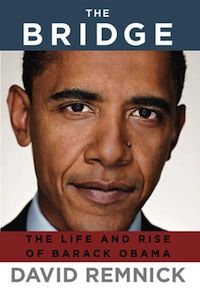The Bridge to Somewhere

Given the subject—Barack Obama—and the author—Pulitzer Prize-winning writer and New Yorker editor David Remnick—it makes sense that Remnick’s new tome, The Bridge (Knopf), would receive widespread attention and review coverage.
And it probably would, at some point, make more sense or be (at the least) more interesting to render a careful exegesis of the more serious analytical efforts. One point Remnick draws out in his sensible and extensive profile of Barack Obama during his rise to presidential candidacy is that he was something of a political/cultural Rorschach test. That seems to be the case with Remnick’s opus.
Reading Remnick’s book—at a reader’s pace, not as a journalist—I was struck that most public commentary and discussion would for various reasons ignore an important aspect of Remnick’s effort: his (subtle) style and the readability of a 600-page political biography. Consider how less-nuance-sensitive journalists (I’m thinking Bob Woodward) would have handled this gem:
Surely, the most absurd moment of Obama’s first year in office came not long after he committed more than thirty-thousand new troops to Afghanistan. On October 9, 2009, Robert Gibbs woke the President with a call at around six in the morning to tell him that there had been an announcement in Oslo: Obama, after less than nine months in office, had been awarded the Nobel Prize for Peace. The President’s reaction was a more elongated and colorful version of “Shut up.”
Given the worn-out old saw about journalism being the “first draft of history” (given the extensive research, I think this book accounts for a few drafts), I assume responsible political journalists and a broad swath of (a narrow landscape?) America’s intelligentsia will pick this book up and even read it cover to cover. Luckily for the rest of us, Remnick has written something more lively than the plodding narratives cooked up by the usual political journalists qua historians, and included some interesting digressions. E.g., we are treated to the amazing story of Mary Lincoln Todd’s black seamstress Elizabeth Keckley and vivid asides such as this:
TremeThe Wire
My only vexation regarding this otherwise first-rate piece of reporting and analysis is Remnick’s twice glossing over Barack Obama’s reneging on his promise to use public funds for his campaign, which would have placed spending limits. The fact that the President spent more than a half billion dollars more than his opponent is no small matter.
